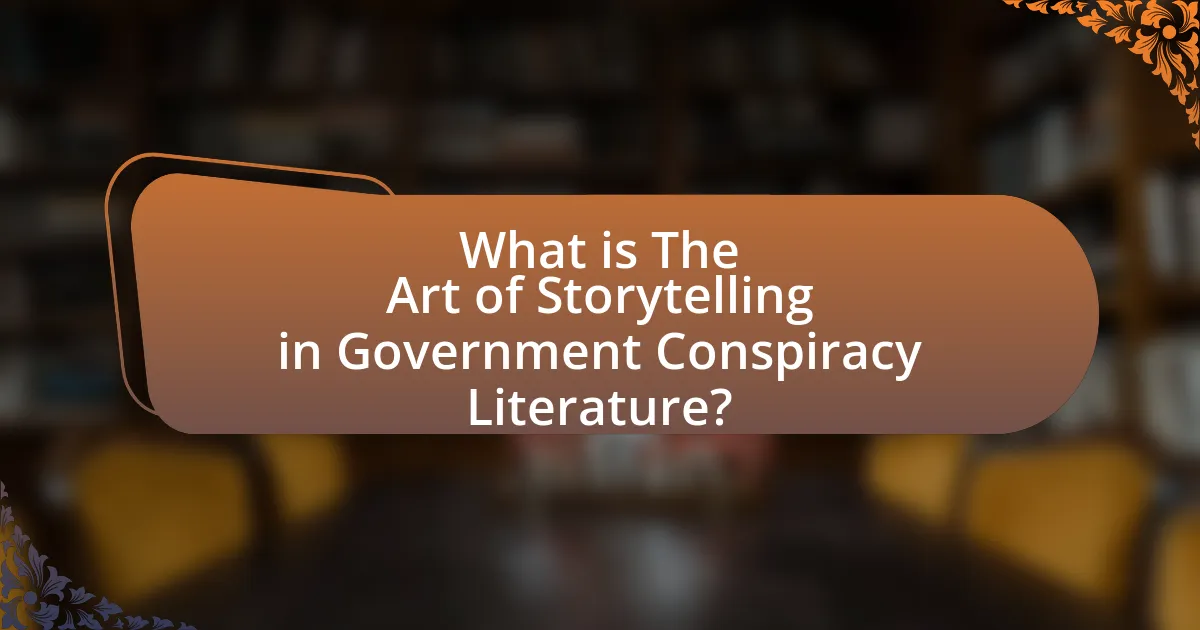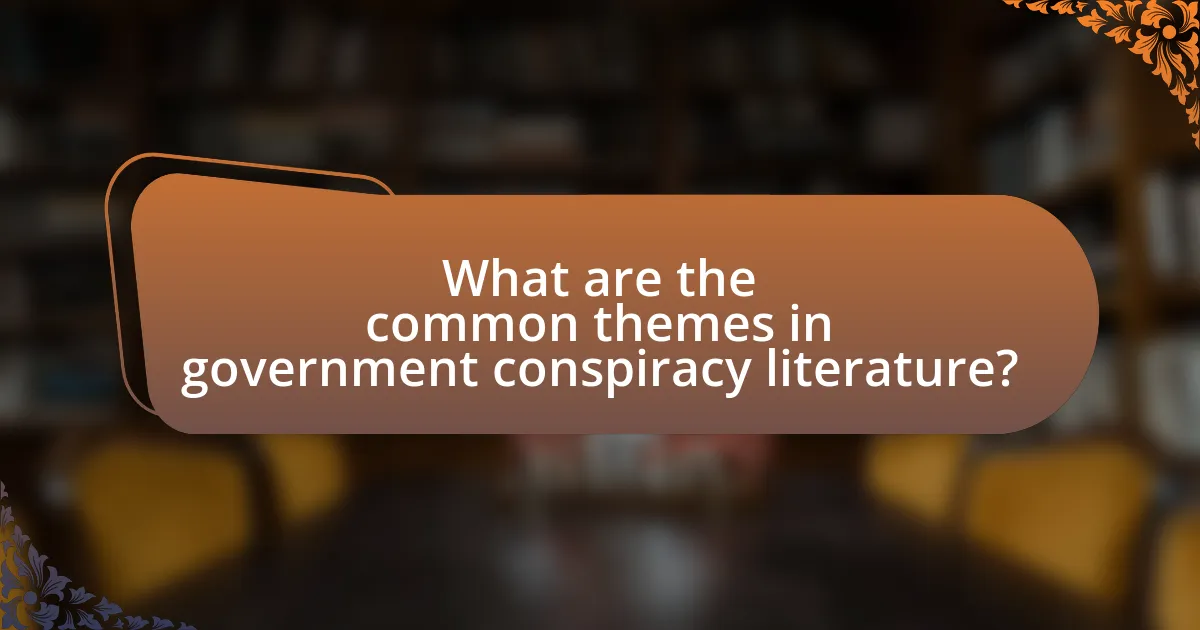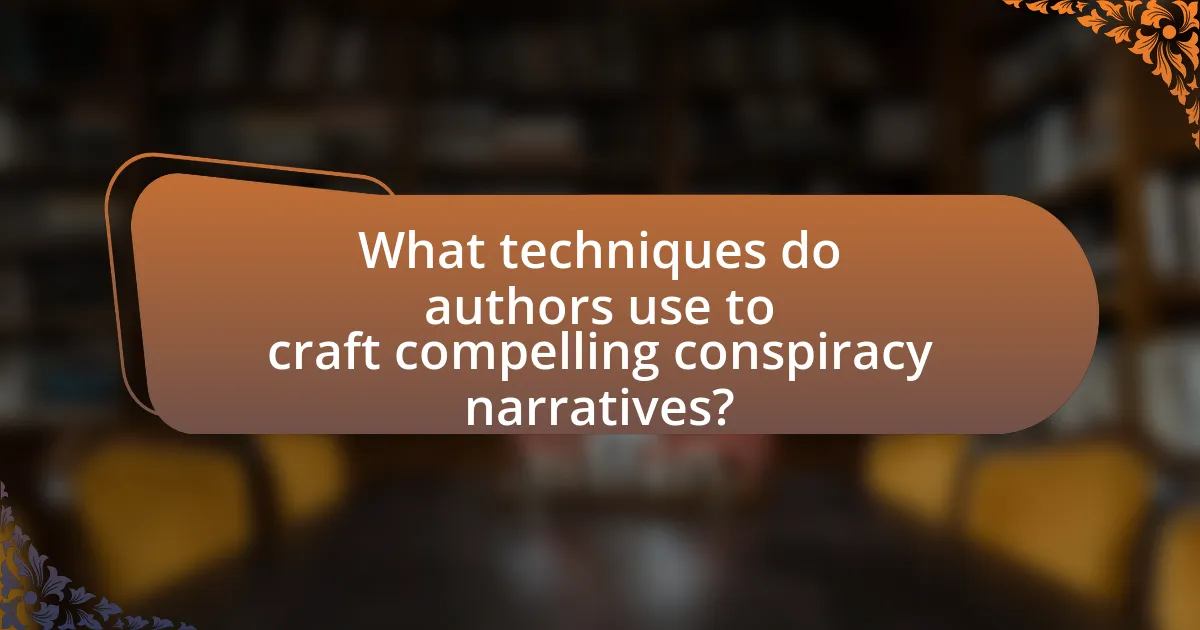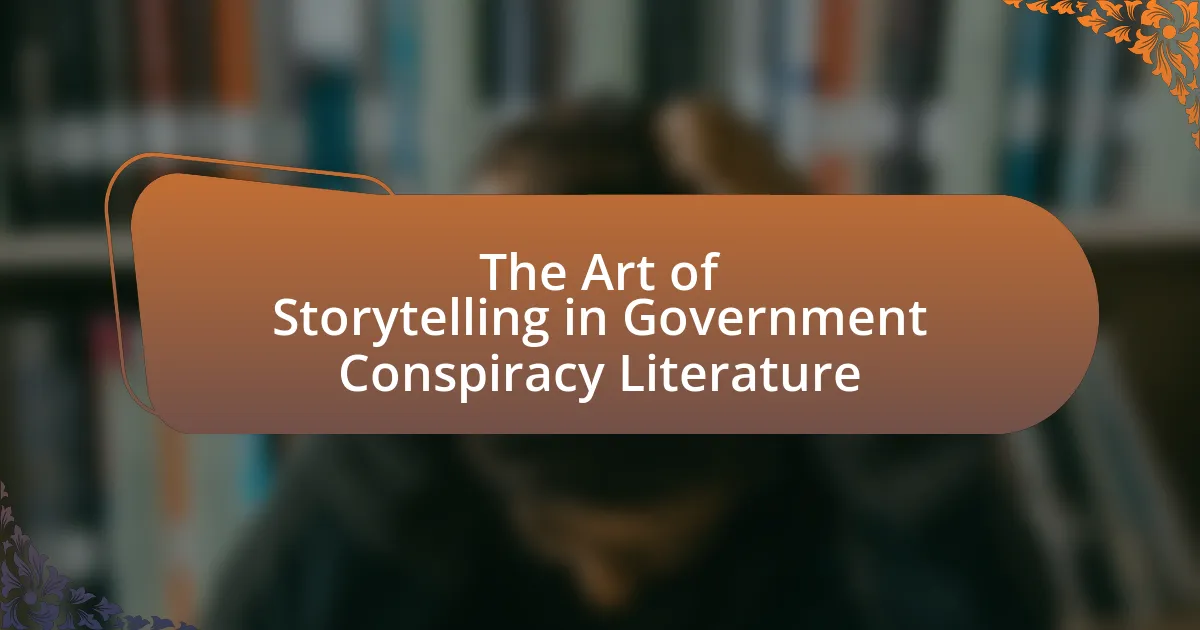The article explores the art of storytelling in government conspiracy literature, emphasizing how narratives engage readers through suspense, intrigue, and the examination of hidden truths. Key elements include complex plots, unreliable narrators, and themes of distrust and secrecy, which challenge perceptions of authority. The article also discusses narrative techniques such as character development and emotional appeal, highlighting their role in shaping belief and enhancing the credibility of conspiracy theories. Additionally, it examines prevalent character archetypes and offers practical tips for aspiring writers to effectively craft compelling conspiracy narratives.

What is The Art of Storytelling in Government Conspiracy Literature?
The art of storytelling in government conspiracy literature involves crafting narratives that engage readers through suspense, intrigue, and the exploration of hidden truths. This genre often utilizes techniques such as unreliable narrators, intricate plots, and a blend of fact and fiction to create a compelling atmosphere that challenges the reader’s perception of reality. For instance, works like “The Parallax View” and “The Manchurian Candidate” illustrate how storytelling can manipulate public perception and provoke critical thinking about authority and power structures. These narratives often reflect societal fears and anxieties, making them resonate with audiences and prompting discussions about the nature of truth and deception in governance.
How does storytelling shape the narrative in government conspiracy literature?
Storytelling shapes the narrative in government conspiracy literature by creating compelling frameworks that engage readers and evoke emotional responses. This genre often employs archetypal characters, such as the whistleblower or the corrupt official, which resonate with audiences and enhance relatability. For instance, narratives like those found in “The Parallax View” or “JFK” utilize suspense and intrigue to draw readers into complex plots that challenge official narratives. Additionally, storytelling techniques such as foreshadowing and unreliable narrators contribute to a sense of mystery and provoke critical thinking about the information presented. These elements not only captivate readers but also encourage them to question authority and seek deeper truths, reinforcing the genre’s appeal and impact.
What are the key elements of storytelling in this genre?
The key elements of storytelling in government conspiracy literature include a complex plot, unreliable narrators, and themes of distrust and secrecy. Complex plots often involve intricate layers of deception, where characters uncover hidden truths about government actions or policies. Unreliable narrators create ambiguity, challenging readers to question the validity of the information presented. Themes of distrust and secrecy highlight the tension between authority and individual perception, reflecting societal concerns about transparency and accountability. These elements work together to engage readers and provoke critical thinking about real-world issues related to government actions.
How do authors use narrative techniques to engage readers?
Authors use narrative techniques such as suspense, character development, and unreliable narration to engage readers. Suspense keeps readers on edge, compelling them to continue reading to uncover the truth behind the conspiracy. For example, in “The Parallax View,” the gradual revelation of hidden agendas creates tension that captivates the audience. Character development allows readers to form emotional connections with protagonists, making their journeys more impactful; in “The Manchurian Candidate,” the protagonist’s internal struggles resonate with readers, enhancing their investment in the story. Unreliable narration challenges readers to question the truth, as seen in “The Crying of Lot 49,” where ambiguity invites deeper analysis and engagement. These techniques effectively draw readers into the narrative, making them active participants in unraveling the conspiracy.
Why is storytelling important in conveying conspiracy theories?
Storytelling is important in conveying conspiracy theories because it creates a compelling narrative that engages audiences emotionally and intellectually. This narrative structure helps to simplify complex ideas, making them more relatable and easier to understand. For instance, conspiracy theories often involve intricate plots and characters, which storytelling can effectively illustrate, thereby enhancing the persuasive power of the theory. Research indicates that narratives can significantly influence belief formation; a study published in the journal “Cognitive Science” by Green and Brock (2000) found that individuals who engage with stories are more likely to accept the information presented within them as true. This demonstrates that storytelling not only captures attention but also shapes perceptions, making it a crucial tool in the dissemination of conspiracy theories.
How does storytelling enhance the believability of conspiracy theories?
Storytelling enhances the believability of conspiracy theories by creating a compelling narrative that resonates emotionally with individuals. This narrative structure often includes relatable characters, dramatic conflicts, and resolutions that make the theory more engaging and memorable. Research indicates that narratives can influence belief systems by providing context and coherence, making the information more digestible and persuasive. For instance, a study published in the journal “Psychological Science” found that stories can significantly impact how people perceive information, leading them to accept implausible claims when presented in a narrative format. This emotional engagement and cognitive ease contribute to the perceived credibility of conspiracy theories.
What role does emotional appeal play in storytelling within this context?
Emotional appeal serves as a crucial mechanism in storytelling within government conspiracy literature by engaging readers on a personal level and fostering a sense of urgency and connection to the narrative. This genre often utilizes fear, distrust, and intrigue to evoke strong emotional responses, which can enhance the reader’s investment in the story and its themes. For instance, narratives that highlight government secrecy or betrayal can provoke feelings of paranoia and skepticism, compelling readers to question their own realities. Research indicates that emotionally charged stories are more memorable and persuasive, as they activate the brain’s emotional centers, making the content resonate more deeply with the audience. This emotional engagement not only captivates readers but also drives them to explore the implications of the conspiracy, thereby reinforcing the overall impact of the storytelling.

What are the common themes in government conspiracy literature?
Common themes in government conspiracy literature include distrust of authority, secrecy, and the manipulation of information. These themes often reflect societal anxieties about government transparency and accountability. For instance, the Watergate scandal exemplifies the theme of distrust, as it revealed the extent to which government officials would go to conceal their actions. Additionally, the theme of secrecy is prevalent in narratives surrounding events like the assassination of John F. Kennedy, where speculation about hidden truths fuels conspiracy theories. The manipulation of information is highlighted in works discussing the media’s role in shaping public perception, as seen in the portrayal of events like the Gulf of Tonkin incident, which was used to justify military action. These themes collectively underscore a pervasive skepticism towards governmental institutions and their narratives.
How do these themes influence the storytelling process?
Themes in government conspiracy literature significantly influence the storytelling process by shaping narrative structure, character development, and reader engagement. For instance, themes such as distrust in authority and the quest for truth drive the plot, compelling characters to navigate complex moral dilemmas and uncover hidden agendas. This thematic focus creates tension and suspense, essential elements in maintaining reader interest. Additionally, the exploration of paranoia and secrecy often leads to intricate world-building, enhancing the immersive experience for the audience. Studies indicate that narratives rich in these themes resonate more with readers, as they reflect societal anxieties and provoke critical thinking about real-world issues.
What are the most prevalent themes found in this genre?
The most prevalent themes found in government conspiracy literature include distrust of authority, the quest for truth, and the impact of secrecy on society. Distrust of authority is often depicted through characters who challenge governmental narratives, reflecting a broader skepticism towards institutions. The quest for truth is a central theme, as protagonists typically embark on journeys to uncover hidden realities, often leading to personal transformation. Additionally, the impact of secrecy on society is explored, illustrating how concealed information can lead to societal unrest and individual paranoia. These themes resonate with readers, as they reflect real-world concerns about transparency and accountability in governance.
How do these themes reflect societal concerns and fears?
Themes in government conspiracy literature reflect societal concerns and fears by illustrating the distrust in authority and the anxiety surrounding governmental transparency. For instance, narratives often depict powerful entities manipulating information, which resonates with public skepticism about political motives, especially in contexts like the Watergate scandal or the 9/11 attacks. These stories serve as a mirror to societal apprehensions regarding surveillance, loss of privacy, and the potential for abuse of power, highlighting a collective fear of being controlled or misled by those in positions of authority.
Why do readers gravitate towards these themes?
Readers gravitate towards themes in government conspiracy literature due to their inherent intrigue and the exploration of power dynamics. These themes often reflect societal anxieties about authority, transparency, and the unknown, resonating with readers’ desires for understanding complex realities. For instance, a 2019 study published in the journal “Psychological Science” found that narratives involving conspiracies can fulfill a psychological need for certainty in uncertain times, making them appealing. Additionally, the thrill of uncovering hidden truths engages readers, as seen in popular works like “The Da Vinci Code,” which combines historical elements with conspiracy, drawing significant readership and discussion.
What psychological factors drive interest in conspiracy narratives?
Psychological factors driving interest in conspiracy narratives include a desire for control, cognitive closure, and social identity. Individuals often seek to make sense of complex events, and conspiracy theories provide simplified explanations that enhance their sense of understanding and control over uncertain situations. Research indicates that people with high levels of anxiety or a need for cognitive closure are more likely to endorse conspiracy beliefs, as these narratives offer definitive answers to ambiguous circumstances. Additionally, social identity plays a crucial role; individuals may gravitate towards conspiracy theories that align with their group beliefs, reinforcing their sense of belonging and identity. Studies, such as those by Goertzel (1994), have shown that these psychological needs significantly correlate with the acceptance of conspiracy theories, highlighting the interplay between individual psychology and social dynamics in shaping interest in such narratives.
How does the cultural context shape the reception of these themes?
Cultural context significantly shapes the reception of themes in government conspiracy literature by influencing how audiences interpret narratives and symbols. For instance, in societies with a history of governmental mistrust, such as the United States post-Watergate, conspiracy themes resonate more deeply, as they reflect existing skepticism towards authority. This is evidenced by the popularity of works like “The Parallax View,” which emerged during a time of heightened public distrust in government institutions. Additionally, cultural factors such as media consumption habits and historical events can alter the perceived credibility of conspiracy narratives, making them either more relatable or dismissible depending on the audience’s background. Thus, the interplay between cultural context and thematic reception is crucial in understanding the impact of conspiracy literature.

What techniques do authors use to craft compelling conspiracy narratives?
Authors craft compelling conspiracy narratives using techniques such as intricate plotting, character development, and the incorporation of real-world events. Intricate plotting involves weaving together multiple storylines and red herrings that create suspense and keep readers guessing. Character development is crucial, as authors often create relatable protagonists who uncover hidden truths, allowing readers to engage emotionally with the narrative. Additionally, incorporating real-world events lends credibility to the story, as seen in works like “The Da Vinci Code” by Dan Brown, which intertwines historical facts with fiction, making the conspiracy feel plausible. These techniques collectively enhance the narrative’s appeal and immerse readers in the conspiracy’s complexities.
How do authors build suspense and intrigue in their stories?
Authors build suspense and intrigue in their stories by employing techniques such as foreshadowing, pacing, and creating complex characters. Foreshadowing hints at future events, which keeps readers guessing and engaged; for example, a seemingly minor detail may later reveal critical information. Pacing involves controlling the speed of the narrative, often using short, abrupt sentences during tense moments to heighten urgency. Complex characters with hidden motives or secrets add layers of unpredictability, making readers eager to uncover their true intentions. These techniques are widely recognized in literary analysis, as seen in works like “The Da Vinci Code” by Dan Brown, where suspense is meticulously crafted through these methods.
What narrative structures are commonly employed in conspiracy literature?
Conspiracy literature commonly employs narrative structures such as the unreliable narrator, fragmented timelines, and circular storytelling. The unreliable narrator creates doubt about the truthfulness of the information presented, engaging readers in questioning the narrative’s authenticity. Fragmented timelines disrupt chronological order, allowing for suspense and the gradual revelation of hidden connections, which is a hallmark of conspiracy themes. Circular storytelling often leads back to the beginning, reinforcing the idea that conspiracies are pervasive and inescapable. These structures enhance the complexity and intrigue of the narratives, drawing readers into a web of suspicion and speculation.
How do pacing and timing affect the storytelling experience?
Pacing and timing significantly influence the storytelling experience by controlling the rhythm and flow of the narrative. Effective pacing can build suspense, enhance emotional impact, and maintain reader engagement, while poor pacing may lead to confusion or disinterest. For instance, in government conspiracy literature, a rapid pace during critical revelations can heighten tension, as seen in works like “The Parallax View,” where quick cuts between scenes create urgency. Conversely, slower pacing allows for deeper character development and world-building, as demonstrated in “The X-Files” series, where deliberate timing fosters a sense of mystery and intrigue. Thus, the strategic use of pacing and timing is essential for crafting compelling narratives that resonate with audiences.
What role do characters play in government conspiracy literature?
Characters in government conspiracy literature serve as vehicles for exploring themes of distrust, power, and the quest for truth. They often embody various perspectives, such as the whistleblower, the skeptic, or the complicit official, which allows readers to engage with complex moral dilemmas and societal critiques. For instance, in novels like “The Parallax View,” characters navigate a web of deception, reflecting real-world concerns about governmental transparency and accountability. This character-driven approach not only enhances narrative tension but also invites readers to question the reliability of information and the motives behind authority figures, thereby reinforcing the genre’s critical examination of power dynamics.
How are protagonists and antagonists typically portrayed?
Protagonists in government conspiracy literature are typically portrayed as determined individuals seeking truth and justice, often facing overwhelming odds. These characters are often depicted as relatable heroes who possess strong moral convictions, driving them to uncover hidden agendas and challenge corrupt systems. In contrast, antagonists are usually characterized as powerful figures or organizations that manipulate information and exert control, embodying deceit and moral ambiguity. This dynamic creates a clear conflict between the protagonist’s quest for transparency and the antagonist’s efforts to maintain secrecy and power. The portrayal of these characters is essential in highlighting themes of resistance against oppression and the struggle for truth within the narrative.
What character archetypes are prevalent in this genre?
In government conspiracy literature, prevalent character archetypes include the Whistleblower, the Skeptical Journalist, and the Government Agent. The Whistleblower often serves as the protagonist who exposes hidden truths, driven by a moral obligation to reveal corruption. The Skeptical Journalist typically investigates the conspiracy, using critical thinking and resourcefulness to uncover evidence, reflecting the genre’s emphasis on truth-seeking. The Government Agent, often portrayed as conflicted, embodies the tension between duty and morality, illustrating the complexities of loyalty within the narrative. These archetypes are essential in driving the plot and engaging readers with themes of truth, power, and resistance.
What practical tips can aspiring writers use to enhance their storytelling in this genre?
Aspiring writers can enhance their storytelling in government conspiracy literature by focusing on thorough research, creating complex characters, and building suspense. Thorough research ensures that the plot is grounded in plausible scenarios, which is crucial in this genre where believability is key; for instance, referencing real historical events or government documents can lend authenticity to the narrative. Creating complex characters allows for deeper emotional engagement, as readers are more likely to connect with characters who have nuanced motivations and backgrounds. Building suspense through pacing and strategic revelations keeps readers engaged, as seen in successful works like “The Da Vinci Code” by Dan Brown, where tension escalates through carefully timed plot twists. These strategies collectively contribute to a compelling narrative that resonates with readers.
